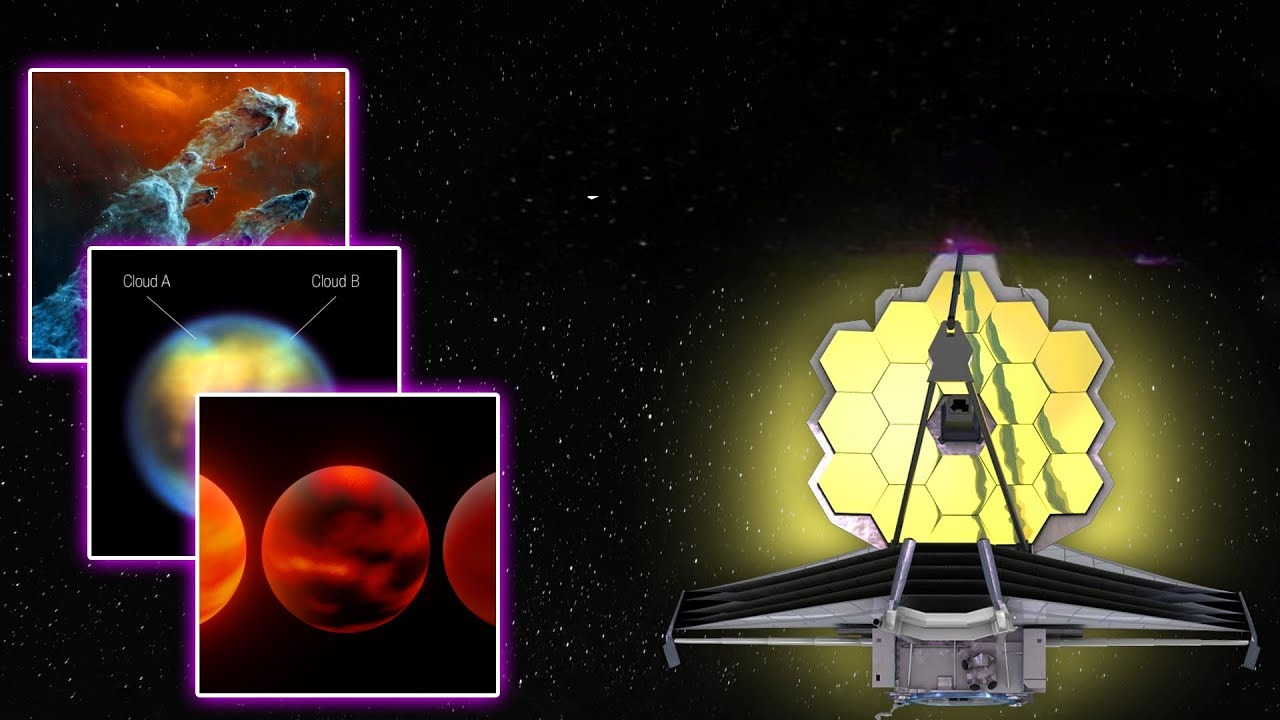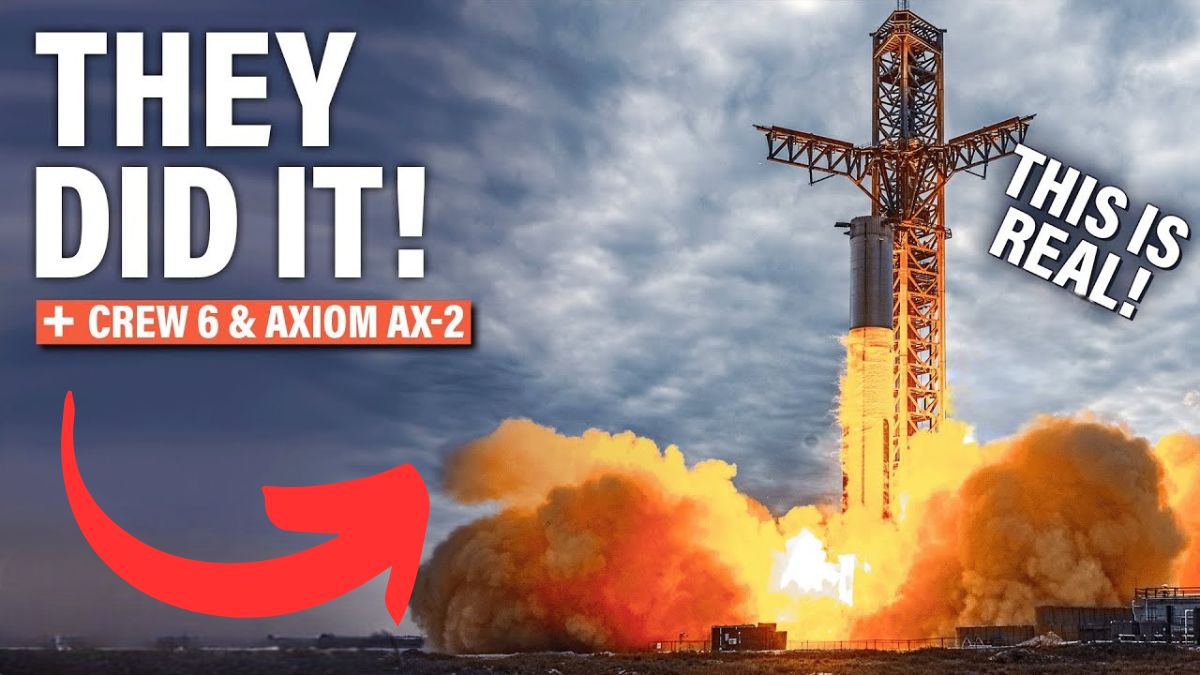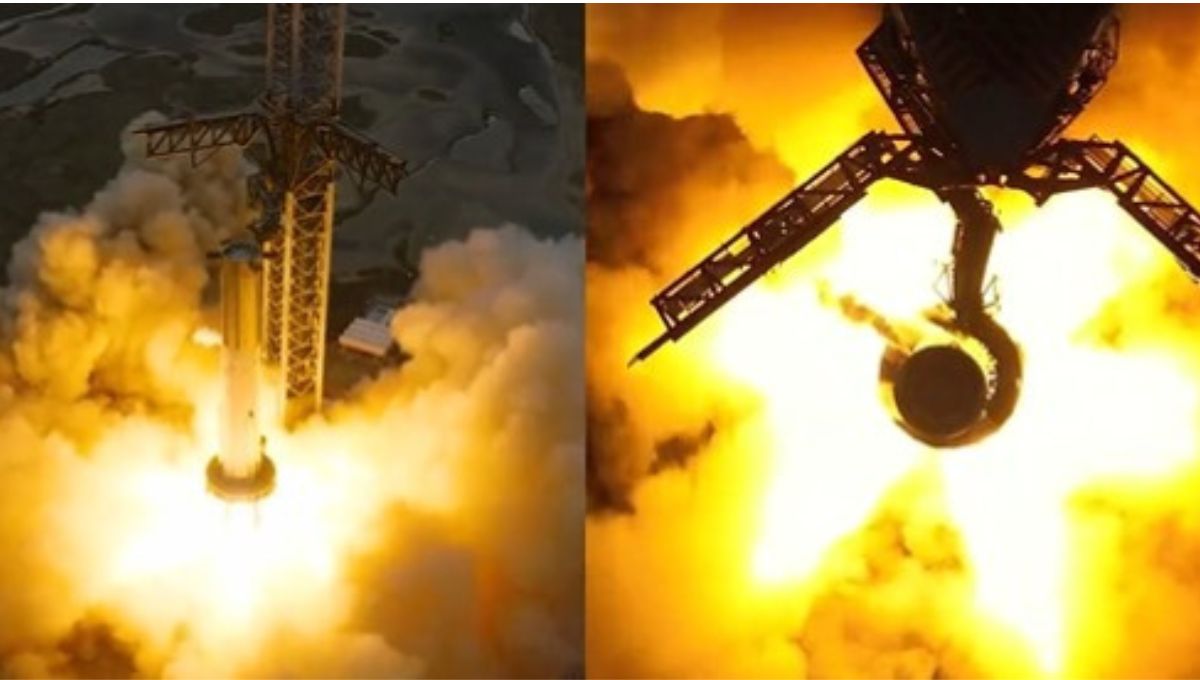
I’ve got an exhilarating ride as we take a peek into the latest news from SpaceX and Starship development this week.
More insights from the aftermath of Booster 7’s static fire.
Then we have scientists discovering a groundbreaking method for discovering near-earth asteroids using the James Webb Space Telescope.
More beautiful Falcon 9 action as launch cadence accelerates.
But some not so great news on a second leaky vehicle at the International Space Station.
Yikes.
Then we’ve got a new mission awarded to Blue Origin?
Yea, no shortage of stuff today, so strap in.
Kicking off with the aftermath of that epic 31 engine Static Fire over a week ago, just look at these simply amazing photos that SpaceX posted more recently.
There is just so much information in those locked away.
First off, you probably recognise the grid-fin actuators on the forward dome, as well as the two main autogenous pressurization pipes entering the methane tank right from the forward dome.
That isn’t all though, as I suspect some of the wrapped up boxes here could very well be the flight computers.
Nestled beneath the interstage connection ring we can also see this, a battery most likely providing power to the flight computers, and much more.
Interestingly enough, there’s also this orange device right here.
It could be that they have something to do with the wireless communications between the Booster and Ship, because they don’t really have a wired connection point as far as we are aware.
There isalso these connections, I’m wondering if one of these eventually leads up to a camera inside the methane tank.
Something we’ve seen in the past with SN11.
So what new information have we learned about the static fire test since last week?
Just take the acoustics for example.
Many nearby seemed to think the test seemed quieter than they would have expected.
Could that really be true though?
With 31 engines firing together, the constructive or destructive interference from each of them can be quite fascinating afterall.
Well, who better to ask?
I asked Elon himself who replied to the query here indicating that anecdotally, it wasn’t as loud as they expected.
That is great news, but is that somehow intentionally designed in, or is it just pure luck?
Now Cosmic Perspective has some great slow mo footage of the most recent static fire coming, so keep an eye out for that, but this earlier one from a few months ago is also captured in exquisite slow mo detail.
You can see here the amazing vibrations of the plume pushing the gasses around.
I don’t know if it is even possible to somehow control the resonance of each engine to manipulate the acoustics or not, but if so, that would be a pretty cool way to reduce noise.
Alright, let’s again visit the updates on the speculated water deluge system.
Once again, SpaceX seems to be absolutely flying through the progress here.
One of the main new things to note is the rapid assembly of all of these walls around the perimeter.
If I had to guess, this could be to capture the remaining water that such a system would have left over.
That is because this water probably can’t be released straight into the environment as pollutants may need to be filtered out beforehand.
Now you may remember I’ve talked a few times about one of the Hydraulic Power Units or HPU’s on Booster 7 going missing.
This drives the thrust vector control of the inner booster engines, but why was it taken off?
After a lengthy delay a new one was delivered at the launchsite, and it was marked as Serial Number 15.
Quite the interesting fact about this HPU is that it originally came from Booster 8!
Later that very day the other one was taken off the booster as well.
I’m still not sure why we are seeing these being swapped out, but it does make me happy that SpaceX has switched to electric thrust vector control systems for future vehicles.
SpaceX has been taking delivery of all of these shielding plates over the last week as spotted by Zack here initially.
What are these for though ?
Well, fairly certain they are Orbital Launch Mount shields!
These renders here by Ryan Hansen should give a very good idea of how it all will come together.
Here’s another one of how it should look from the inside.
The crews should still have plenty of room available to walk around and work on added modifications.
But yes, sadly soon we are not going to be able to look at all the intricate internal systems of the launch mount once the covers go up.
Just amazing work done here by Ryan Hansen, and there is some amazing stuff coming soon so keep an eye out.
And to add to the point in discussion here, these shields are crucial…they’re not just here for the looks.
The mess 33 raptor engines could create is no joke, just look at the aerial shots from SpaceX, and you can see that even at 50% thrust already shot flames over the orbital tank farm berm.
Just in case you’re wondering, Elon shared with us that SpaceX aims to run the raptors at 90% thrust during the launch attempt.
Hopefully it will still happen sometime in March!
But why 90% and not 100?
Well my guess would be that Starship will be flying with minimal payload, so there should be plenty of margin for that test flight.
In fact I suspect that SpaceX would want to run the engines at lower thrust simply to have less chance of any anomalies, and a better chance of capturing all the data they can get through each stage of the flight.
Once a few test flights are done, they should then ramp them up to full power.
Now check out this bare looking starship here making an appearance this week!
No heat shield tiles or fins at all.
Yes, Ship 26 finally left the Highbay and immediately rolled towards the Launch site late Saturday evening.
There it was turning into the Launchsite and just before 1am in the morning, it was parked next to suborbital pad A.
After an absolutely stunning sunrise, the temporary Quick Disconnect plate which allows SpaceX to pressurize the vehicle during transport was removed.
Just look at the scale of this thing.
You can see here that they are using these rubber O-rings to properly seal all of the connections.
There we have it, it was time for it to be lifted onto the suborbital pad.
So with this ship prototype missing all the hardware needed for reuse, why does it still have its nose cone and thrust section pins to mount heat shield tiles.
Well you may recall that in the past this very nosecone actually had tiles, but SpaceX removed those.
There’s a lot more intriguing stuff to discover here compared to previous ships.
Likely changes that we’ll see implemented on the future Ships being created.
This here is its flight termination system box, and it has changed.
When looking at previous ships, it is now a lot more angular.
Looking right below that, at the Liquid Oxygen tank, that has now gained some support stringers on the inside.
Those would add a little mass but I suspect would also allow SpaceX crew to work inside of the tanks without needing to hook up to the crane up for added support.
Down at the thrust section this extra strip has been enlarged to now fully overlap the weld from the thrust dome.
Just below that we can see these weld doublers again.
I covered those in greater detail a while ago for Ship 24, but for Ship 26 we get extra detail and we can see that they do indeed run all the way around the ship, including where the Thermal Protection System tiles would go.
It is a bit of a frankenstein really.
Over here these are the remains of the aft flap hardware right next to one of the engine chill lines.
We of course expect to see all the hardware return with Ship 28, the next one to get the full set of tiles back.
Before that though, production of Ship 27 has finally restarted.
Its forward dome was moved inside the Highbay, followed by its nose cone stack.
A few hours later SpaceX used the bridge crane to place the nosecone on top.
Like Ship 26, Ship 27 is also not going to have any of those tiles installed, but it does thankfully have a Starlink PEZ dispenser.
That I have to say does look a lot more reinforced than the previous ones that ended up being closed off.
So yes!
It has been a big week for SpaceX in Texas, but one little thing you may have missed is the news on the two oil rigs named Phobos and Deimos.
SpaceX had planned to convert those into offshore launch platforms after purchasing them in 2020.
I’ve had no shortage of questions about this over the past year, and I can finally give you an update.
And that is… that, SpaceX have just sold them.
Yep.
Gwynne Shotwell has stated “they were not the right platform, but are still interested in sea-based launch platforms.
” So I guess we will need to see where it goes from here.
We also have an unexpected asteroid discovery to talk about.
Observations of a known main belt asteroid, located between the orbits of Mars and Jupiter, were conducted by the James Webb Space Telescope, to help calibrate and test the performance of some of MIRI’s filters.
However, amazingly while analyzing the data, the team found a small asteroid in the same field of view.
How small?
Well very actually.
Quite comparable to Dimorphos which was the target of the DART mission.
This freshly spotted asteroid is about 150 meters in diameter.
Similar to the size of Rome’s Colosseum.
It is yet to be confirmed as a newly discovered asteroid, but what is interesting is this.
It seems to be the smallest object spotted by James Webb and, more importantly, the team suspects that any MIRI observations made close to the plane of the solar system, could almost always include a few asteroids.
Many of which will be totally unknown objects.
This is great news I think because these smaller sized asteroids are notoriously hard to detect in abundance.
With this new method of asteroid detection, we could redefine our view on this region of space, and increase our chances of spotting potentially dangerous asteroids.
The sooner we can find them, the better chance we have to target them for future redirect missions.
[Ad Start] It’s amazing how much we’ve discovered about the depths of the cosmos, and yet we still find it difficult to agree about events taking place on our own planet.
This thought is what inspired Harleen Kaur, a former NASA engineer, to build a news platform.
“Since I was a little girl I really wanted to be an astronaut and I was lucky enough to work for NASA.
I got to work on a program called New Horizons and it was the first spacecraft that was being built to be sent all the way to Pluto and beyond.
” Later in her career, Harleen was working on jet engines for Rolls Royce, the manufacturer of the Malaysian Airlines Flight 17 engines, when she received information of the fatal double engine failure in 2014.
“It was amazing that we had to wait hours until a camera crew, a journalist, went to the site and figured out what happened to the plane and to be honest we still really don’t know what happened to that plane …” She started to think about a better way to share news and verify information in real time by comparing multiple perspectives from journalists on the ground and around the world.
We’ve had some really amazing Starlink action this week too.
SpaceX’s Falcon 9, booster 1062, took off from Space Launch Complex 40 from Florida last Sunday.
This was its 12th flight trailing the record holders with 15 flights, and in this one it was carrying 55 Starlink satellites to the fifth shell in orbit.
Another breathtaking night-time launch we had here.
A totally blinding lift off actually.
It never gets old watching that booster light up the night’s sky, and in this particular case, they kept the ground camera fixed on the booster showing that plume expansion as the altitude rapidly increased and atmosphere thinned out.
Just look at that.
I’ve obviously sped this footage up here because it continued all the way to main engine cut off.
I think it is worth a quick mention that this launch actually broke the pad turnaround record for Falcon 9.
This launch took place just after five days, three hours, and 38 minutes after the Amazonas Nexus mission.
With The payload’s fate now in the hands of the upper stage attention shifted back to that booster and its return to the droneship.
Yet another textbook landing incoming on A Shortfall of Gravitas.
No signal loss at all.
And of course, the successful deployment of all the 55 Starlink satellites was confirmed on Twitter along with these wonderful shots.
Falcon 9 there blasting off with the waning moon in the background.
I think this one is now my Desktop background for the week.
And you’d be wrong if you thought that was it for Starlink because at the end of the week, another batch launched from across the country from Vandenberg Space Force base.
This time we had Falcon 9, booster 1063 on its 9th launch with another batch of 51 Starlink satellites.
Yet another terrific burst through the blue skies.
Just a few minutes later, we had good separation.
The upper stage ignited its engines and there it went on its way to put those satellites into orbit as well.
Here another landing burn again for the 2nd time in the week.
I will say that this launch cadence is really continuing to accelerate, and when SpaceX keeps making it look this easy?
Well, it is no wonder really is it.
There we are, touchdown this time on the drone ship Of Course I Still Love You names of course from the Culture series novel The Player of Games.
That is the same for the droneship Just Read the Instructions too.
Many don’t actually realize why the ships are named in this “odd” kind of way, so hopefully that clears it up for you if you’ve been curious.
With this mega constellation growing every week, we are starting to see Starlink coverage rapidly expand again just recently.
We have ZIPAIR, a Japanese airline, which is soon also going to have Starlink connections, and quite a few new Starlink availability updates now on the map getting that sweet blue access.
We’ve seen tweets announcing that availability in Colombia, Brazil and Iceland.
Then Elon himself announced Starlink in Italy!
That is great news for these countries.
Would you then believe a third Falcon 9 launch for the week?
Yep that’s right, just a handful of hours ago as I was about to render this video to get it up in time we had the Inmarsat-6 F2 mission.
Falcon 9 has indeed pulled off a hat trick this week, with this booster on its third mission.
Again from Space Launch Complex 40 at Cape Canaveral, all the way up to stage separation.
Fairing deployment and there we could see the Inmarsat-6 there on its way today into a geostationary transfer orbit.
Of course while that was taking place the Falcon 9 booster landing on the droneship Just Read the Instructions.
Three amazing landings this week on all three droneships.
How cool is that!
Last week, you may recall I talked about the Progress MS-22 successfully docking to the station to provide those much needed fresh supplies.
Soon after that happened though, we received some shocking news.
The predecessor of the newly docked Progress, Progress MS-21 which is the one currently docked to the Poisk’s zenith docking port, encountered a serious problem.
Its cooling loop was depressurized just half an hour after the new spacecraft docked.
What!
Yes it looked like we were seeing another leak.
The hatches between this and the hatches were open, but the temperature and pressure aboard the station was all still normal.
Most importantly the crew were all safe and sound.
So what was going on here?
The leaky Progress MS-21 was launched all the way back in October to deliver cargo to the station.
Now that its mission was complete, it did seem like this would delay the undocking process for quite some time, however instead this vehicle has now been loaded with garbage, and was undocked just hours before uploading this week’s video.
The cosmonauts at that point rotated the vehicle after undocking and took pictures of the damaged area for more information.
The big worry here is that the first leaky Soyuz MS-22 was discovered back in December a few months ago.
A strikingly similar problem.
I’ve been covering that fairly frequently here but if you’ve missed it, in a nutshell, this Soyuz suffered from a cooling radiator leak.
Unlike this new leak which is hard to see directly, MS-22 was very visible.
In fact we could even see matter showering out of the spacecraft’s radiator after spending about 80 days after it had arrived at the station.
After some investigation, the leak was considered to be due to a micrometeoroid hit.
A second leak, just under 2 months after the first one though!
Yea, that does raise a little more suspicion.
The possibility of this also being due to another meteoroid strike, on the same external cooling radiator of the spacecraft, is probably well beyond plausible.
This now instead has many thinking that the issue is more related to a common internal defect.
Just think about this.
The first Soyuz MS-22 leak happened after being docked at the station for around 85 days or so.
And if you take a close look at this image released by Roscosmos at the start of the week this brownish stain right here is the leak area from that same leaky Soyuz.
If we zoom in even further you can spot a tiny hole.
That bruising effect around it is usually evidence of a micrometeoroid impact.
Ever since the first Soyuz MS-22 leak, NASA and Roscosmos have been working towards sending a rescue spacecraft to the ISS to bring back the three ‘stranded’ crew back home safely.
The top priority before this second leak was found, was to finish up the Soyuz MS-23 vehicle and launch it uncrewed autonomously to provide recovery.
That launch was scheduled to happen on 20th February in just a few days.
That is also now delayed as announced by Roscosmos as research continues.
Hopefully everything will be sorted out and checked to the nth degree before they give anything a green light.
And best of luck to all involved as they try to find useful data and proof as to why both of these leaks have happened.
You may or may not have also spotted the recent news of NASA selecting Blue Origin to provide launch services for the Mars Escape and Plasma Acceleration and Dynamics Explorers dual-spacecraft mission.
All part of their Venture-Class Acquisition of Dedicated and Rideshare launch services contract.
Might just use the abbreviations for those at this point!
So EscaPADE, much easier to say, was originally set to launch with the Psyche mission.
But that mission’s trajectory requirements had since ruled this out as a secondary payload.
That left its fate in limbo for a while.
Now we have pretty clear confirmation here that EscaPADE will launch on Blue Origin’s New Glenn rocket from Space Launch Complex-36 at Cape Canaveral.
This launch is being suggested for late 2024, but since New Glenn has yet to fly, it’s going to be intriguing to see if that window slips or not.
Interestingly this EscaPADE vehicle is built around Rocket Lab’s configurable Photon platform.
There will be a pair of identical spacecraft intended to study how the magnetosphere of Mars interacts with the solar wind, along with the processes that is driving its atmospheric escape.
Why do they need two for this?
Well, they need to work together to provide observations from two points.
Essentially to provide a stereo picture of this very dynamic environment.
This field of research is super important especially if we do intend to become a multiplanet civilization.
With Mars being our first destination, understanding its magnetosphere in intimate detail is vital.
That is because unlike the one that Earth has got, which protects us from the worst of the radiation hurled at us from space, Mars has one that is patchy at best.
Could there be stable pockets of electromagnetic fields that could assist in finding a better Martian base?
Well, hopefully we are soon going to find out.







